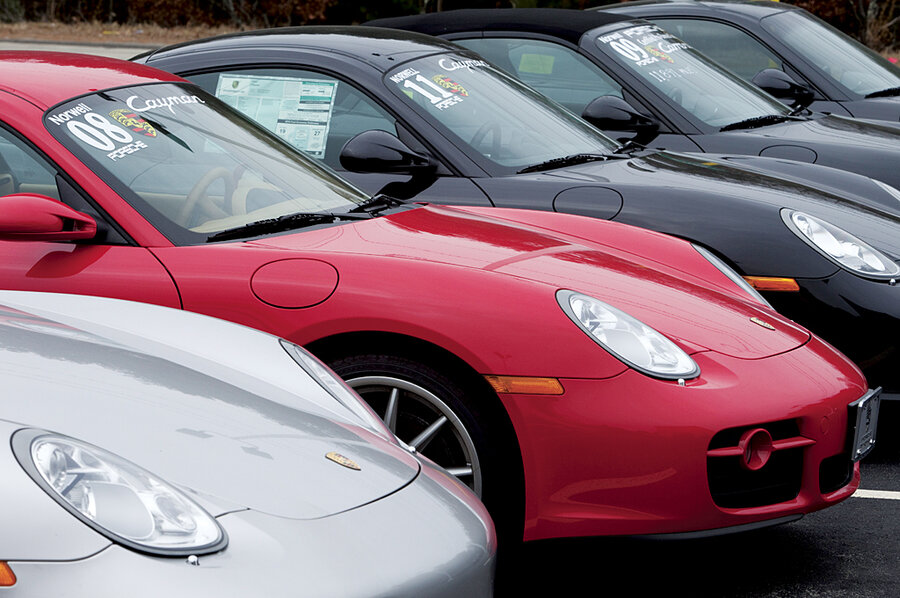Why are used cars so expensive?
Loading...
| Acton, Mass.
The scrap of paper went back and forth across a faux-wood desk, accumulating numbers. The customer poked his calculator, wrote a figure, and passed it over. The car dealer, both thumbs flying over his own oversized calculator, came up with his sum, wrote it down, and passed it back.
In the end, dealer and customer were still $1,000 apart on a used 2010 Subaru Outback parked just outside the door. "I can't meet your price," said the general manager of the Boston-area Subaru dealership. The customer was stunned. The dealer was willing to part with a new 2012 Outback for only $1,700 more than the old one ($1,100 more figuring in cheaper financing and insurance costs). Yes, the 2012 was a demo car so it came with a discount, but it had far fewer miles and was loaded with options. It was a surprising introduction to today's topsy-turvy world of auto economics: For consumers looking for a slightly used vehicle, it's often better to buy new.
"We're seeing extremely high levels of pricing pretty much across the board" for used cars, says Jessica Caldwell, senior analyst at Edmunds.com, an online automotive information company based in Santa Monica, Calif. "A lot of the time, if you're going to buy a late-model used car, it doesn't make financial sense."
Blame the Great Recession. The recent dearth of new car sales (especially in 2009 and 2010), a pullback from leasing, and increased demand for used cars has created the tightest used car market in at least 12 years. Back then, the narrow gap between new and used lasted nine months. Now, it could last a lot longer.
"Maybe you would see some kind of break in the used car prices in a couple years for late models," says Bruce Belzowski, a researcher at the University of Michigan Transportation Research Institute in Ann Arbor. But that assumes the economy continues to mend and new car sales approach normal levels. In 2006, Americans bought 16.5 million new cars and light trucks. In 2012, Edmunds estimates they'll purchase 13.6 million.
Used car prices are so high that new cars are sometimes cheaper.
Take the Mazda CX-9 Touring SUV with all-wheel drive. When Edmunds calculated the cost of a new CX-9 versus a one-year-old certified pre-owned model, it found that it was actually $1,020 less expensive to buy the new one once it figured in financing costs over the five-year life of the loan. A new Mazda2 Sport Hatchback was $480 cheaper than its one-year-old version. Several other cars come close to rivaling their one-year-old versions (see chart).
For the past seven months, the average price of a year-old used car has been less than 12 percent cheaper than a new car, according to the National Automobile Dealers Association (NADA) in McLean, Va. The discount three years ago: 16.7 percent.
New car prices are rising, too. After a decade of producing too many cars, auto-makers have done a better job of keeping production in line with demand, says Laurence Dixon, a senior automotive analyst at NADA. That gives dealers more pricing power. Typically, when the supply of new cars is in line with demand, the average used car discount is about 13 percent. The difference is that so few new cars were sold or leased in 2009 and 2010 that there are fewer of them today to sell used. Light trucks and large sport utility vehicles are in especially short supply, he says.
So what's a car buyer to do? If con-sumers really want a 2009 or newer used car, they should price it against a new vehicle to see the discount, Ms. Caldwell says. They should also factor in all the costs. If they're financing the car, the interest rate on a new car can be two percentage points lower than on a used car. Insurance for a new car can also be slightly less expensive than for an old one.
For those buyers who get sticker shock entering a showroom, one strategy would be to look at older used cars from, say, 2006 and 2007 models. "Over three years old, it's usually a different game," says Mr. Belzowski. "Nowadays, older vehicles are not a bad deal" because they last longer.
Another strategy is to skip dealers entirely and look for individuals selling cars on Craigslist or other online sites or in the classified section. Prices tend to be much lower. "If they want to move it, they may be willing to negotiate," Belzowski says.
Finally, don't wait for your car to deteriorate to the point where it loses much of its resale value, he adds. "Try to anticipate and buy before you absolutely need to."
Back at the Boston-area Subaru dealership, the deal hung in the air. A used 2010 or a new 2012 for $1,100 more? The new one came with a longer warranty and, presumably, two more years of service. The numbers on the scrap paper were too compelling. I bought the new one.







